Understanding what the triceps brachii muscles do helps you to get better results in the gym. For example, knowing that only the biggest head of the triceps (the long head) crosses the shoulder joint, you come to the conclusion that overhead exercises are highly effective for building triceps mass because they place your shoulders into maximum flexion, thus stretching the long head.
The overhead cable extension is an excellent exercise in this regard because it provides your triceps with a growth-stimulating eccentric stretch. However, training both arms together can lead to size asymmetries between your triceps, which, in addition to making your arms look less aesthetic, can also cause the bar to become lopsided during your compound presses.
You can remedy these imbalances (over time and with patience) by doing a single arm tricep extension with a dumbbell. The issue is that free weight tricep drills can cause joint pain for many lifters, which is why cables are often a better option, especially if you intend to lift heavy.
This guide shows you how to do 4 different variations of the one arm overhead cable tricep extension and then discusses the effectiveness of the exercise in general.
Related: Incline cable triceps extension│Cable tricep exercises
One arm overhead cable tricep extension exercise details
- Also Known As: Single arm cable overhead extension, unilateral cable overhead extension
- Main Muscles: Triceps
- Exercise Type: Strength
- Exercise Mechanics: Isolation
- Difficulty Level: Beginner
- Equipment Needed: Cable station, rope attachment
How to do a one arm overhead cable tricep extension

- Position a cable pulley at waist height. A low pulley is also fine, but you should avoid using a high pulley because it’ll reduce the stretch that your triceps get put under.
- Connect a rope attachment to the pulley.
- Grab the rope and then face away from the pulley with the rope behind your head.
- Flex your triceps forcefully to lift the rope up. Keep going until your elbow reaches full extension.
- Lower the rope behind your head in a controlled manner until you feel an intense stretch in your triceps (likely when your biceps and forearms make firm contact at the bottom of the rep).
- Flex your triceps once again to lift the rope until your arm is locked out.
- Perform 3-5 sets of 10-20 reps.
Cable single arm overhead extension variations
Besides the one arm rope overhead tricep extension, there are 3 additional variations of the cable single arm overhead tricep extension that you can perform, each of which has its pros and cons.
Seated cable single arm overhead tricep extension
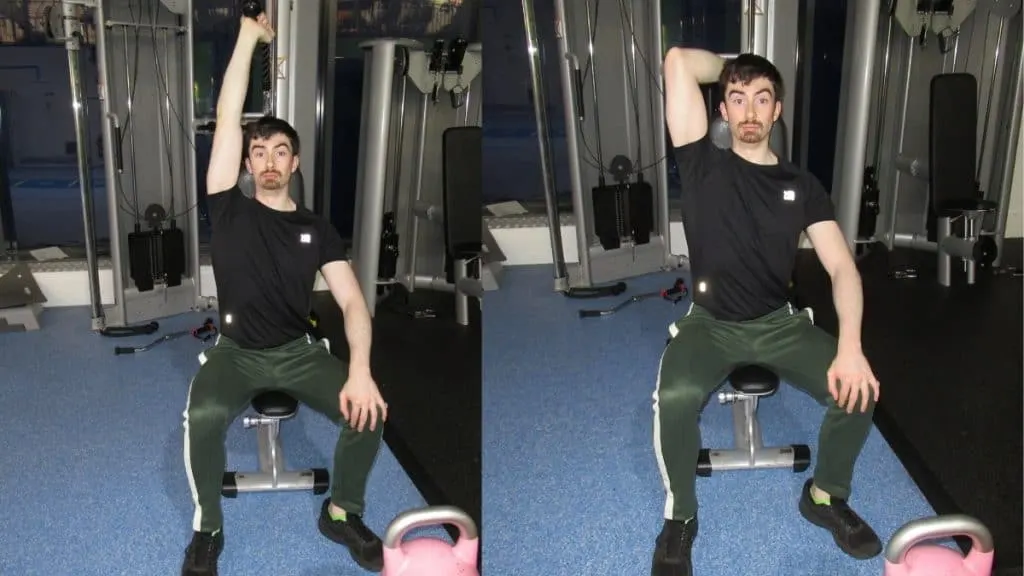
Performing seated overhead cable triceps extensions in a unilateral fashion has two main benefits.
First off, you’re promoting the development of proportional upper arms by ensuring that both of your triceps are getting equal amounts of work.
Second, by doing the exercise seated, you’re drastically reducing the amount of stabilization work that your abs have to perform because your torso is braced against the bench’s back pad. This done-for-you stabilization enables you to put more focus into training your triceps, which, after all, is the primary purpose of this isolation exercise.
The downside (depending on your perspective) is that the seated single arm overhead cable extension burns fewer calories than the standing version because your leg and core muscles aren’t as active when you’re sat down.
As such, if you’re trying to lose fat, then you should stick with the standing single arm rope overhead extension so that you can maximize your energy expenditure.
Conversely, if you’re training for maximum triceps hypertrophy, then the seated one arm overhead cable tricep extension is a better option (so is the seated one dumbbell triceps extension) because you won’t be working your abs at the expense of your triceps.
Of course, if you already have a good mind-muscle connection with your triceps, then having to brace your abs during the standing variation might not impair the activation of your triceps—an effect which is reduced anyway because you’re lifting less weight when you train unilaterally, which means that your core doesn’t have to perform as much stabilization.
One arm overhead cable triceps extension (no attachment)
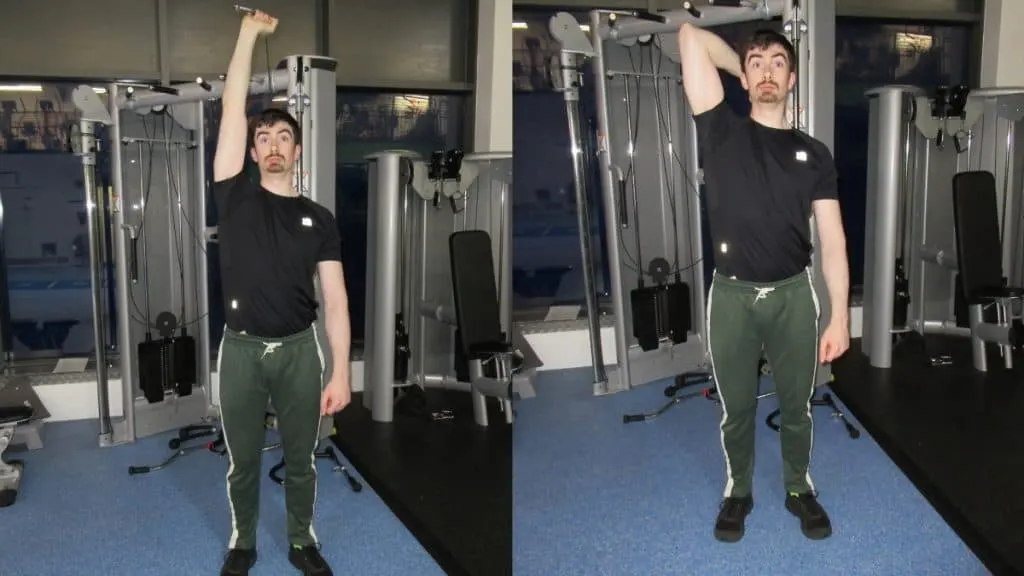
If your gym doesn’t have a single tricep rope, then you’re better off using no attachment at all.
This is because if you use a regular rope, your triceps receive less of a stretch because the distance between the cables and your hand is increased (single ropes are considerably shorter).
Thankfully, most cables have small rubber balls on their ends, which are actually perfect for holding in your palms.
Unlike using a single cable handle, holding the rubber ends of the cable also allows you to keep your wrists in a neutral position, which in turn puts less pressure on your wrists than using a pronated grip.
One arm cable overhead extension (handle)
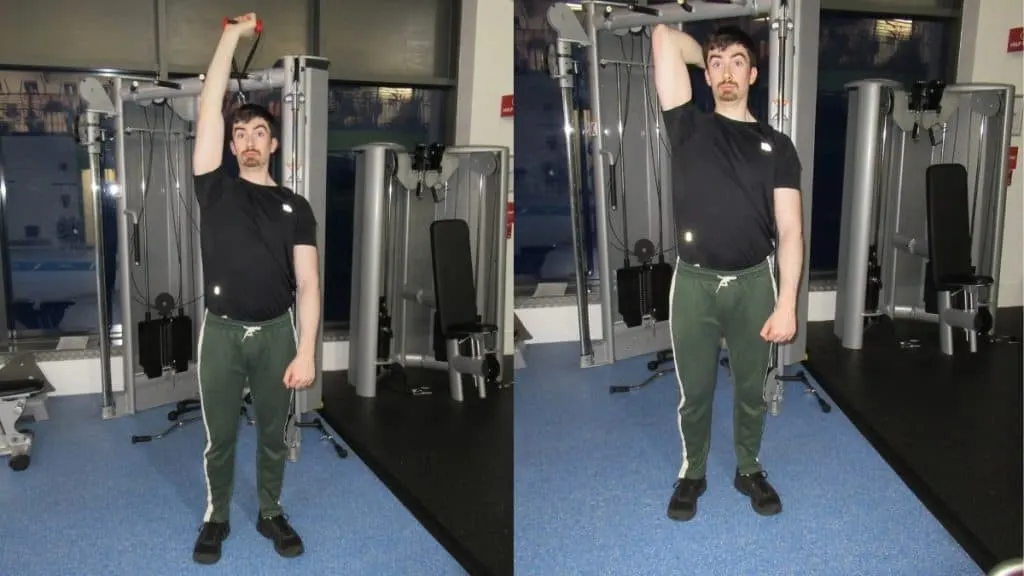
Doing the one arm cable overhead tricep extension with a rope attachment is ideal because it enables you to keep your wrists in a neutral position.
A neutral grip is a more natural position for your wrists than a pronated grip, which is what you’ll be using when you do this exercise with a cable handle.
Of course, any joint stress inflicted by a pronated hand position is tempered by the fact that you’re lifting less weight than usual because you’re training unilaterally.
Still, using a rope provides a stronger peak contraction and a more comfortable tricep training experience, so it’s definitely the attachment of choice for maximizing hypertrophy and workout comfort.
One arm reverse grip cable overhead tricep extension
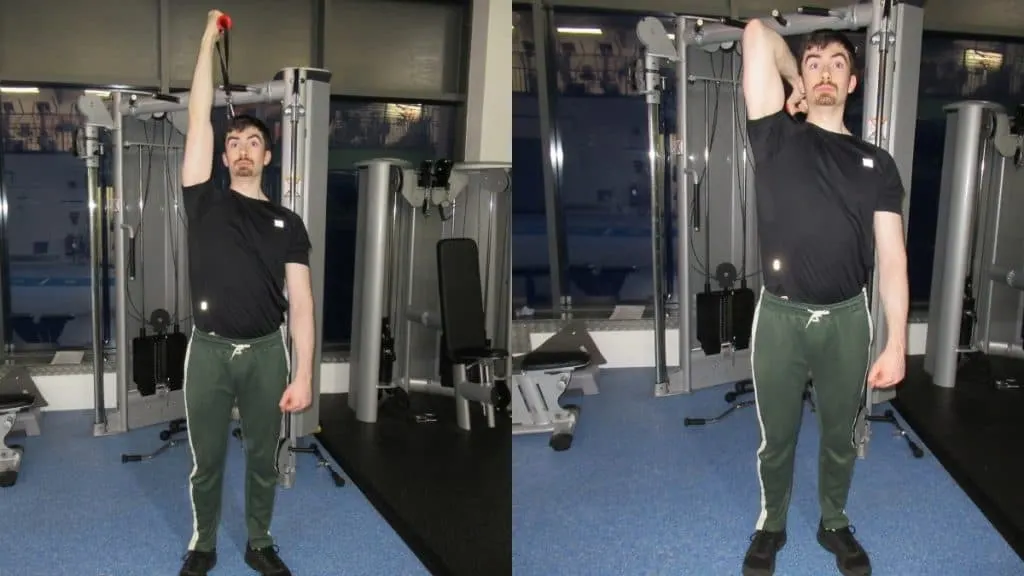
If your gym doesn’t have a single triceps rope and the end of the cables don’t have any grippable rubber balls, then you’re stuck with the cable handle.
This attachment isn’t ideal for the reasons mentioned above, and holding it with a reverse grip may actually make you slightly weaker because you won’t be able to push into the handle with the palm of your hand, which in turn means that you can’t generate as much force.
But it’s not all doom and gloom. Performing the reverse grip overhead tricep extension encourages you to keep your elbow tucked in, which may take some of the pressure off your joints.
You’ll likely also find that a reverse grip, which is to say a supinated grip, is more comfortable than the typical pronated hand position that most lifters default to.
Is the single arm overhead cable tricep extension an effective exercise?
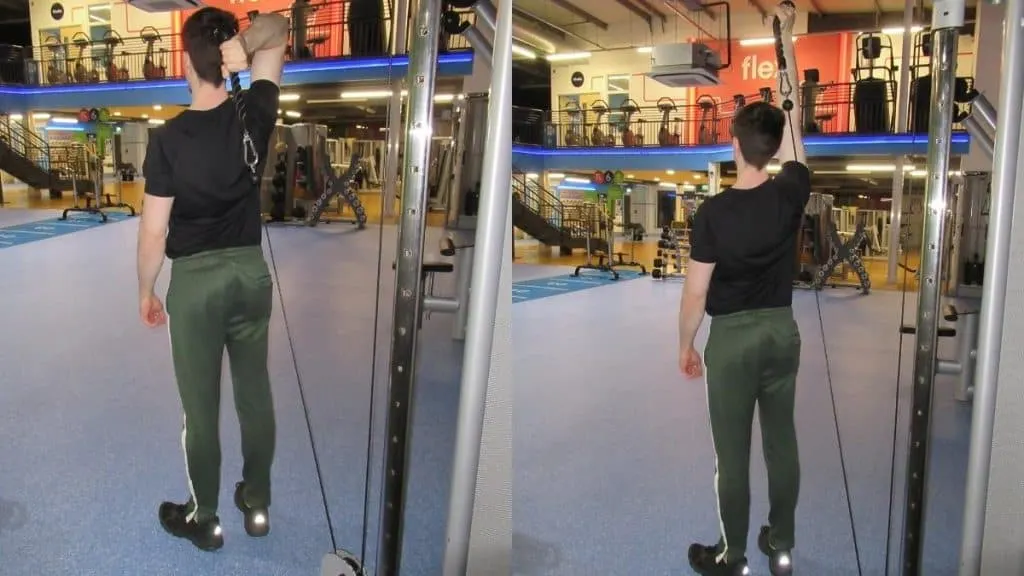
The one arm cable overhead triceps extension is a highly effective exercise for developing a proportional pair of upper arms because it forces you to train each side separately, which in turn ensures that your triceps receive similar amounts of stimulation.
Yet, just because overhead single arm cable extensions are effective doesn’t necessarily mean that they’re the right exercise for everyone.
The single arm cable tricep overhead extension takes much longer to perform than the two-arm version because you’re doing double the number of sets. This is far from ideal if you only have a short amount of time to lift (in which case, you should base your routine around bilateral exercises).
Similarly, if you’re a novice lifter without a solid foundation of muscle mass, then there’s little point in performing unilateral exercises (unless you have obvious muscular imbalances) because you don’t have enough muscle size to make the symmetry—that single-arm exercises provide—visible.
If, however, your triceps could benefit from being more symmetrical and you’re prepared to spend some extra time in the gym in order to improve your physique, then it could be well worth including single arm overhead cable extensions in your routine.
Read More: Cable kneeling triceps extension
Conclusion
Standing one-arm overhead cable extensions challenge your muscles with constant tension while ensuring that both of your triceps receive roughly equal amounts of work.
Building triceps of equal size and strength via single arm cable overhead extensions enhances your upper body aesthetics and also prevents the bar from becoming lopsided during your pressing exercises, which further equalizes the amount of stimulation that your triceps receive.
Aim to perform 3-5 sets of 10-15 reps of the one arm overhead cable tricep extension per session (1-2 sessions per week) and use the rope attachment where possible so that you can maintain a safe, neutral wrist position.

